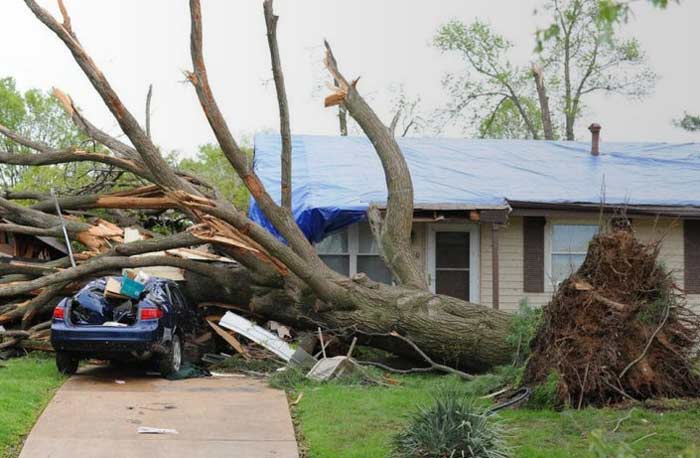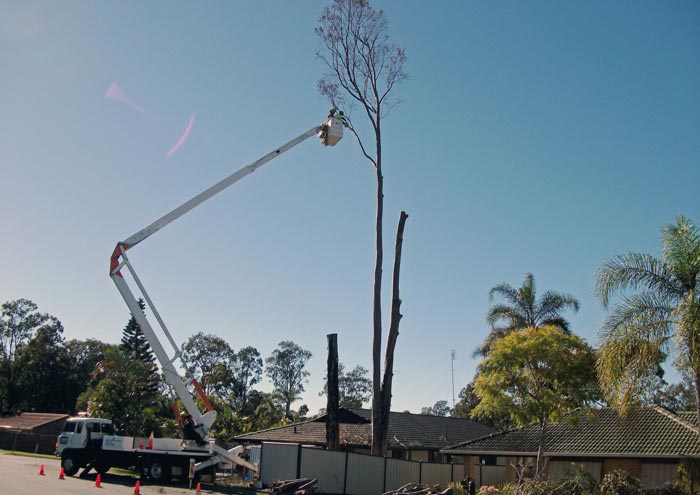First I think it’s important to establish what a dead tree is. When we say “dead tree”, we’re definitely talking about trees that have completely died. They have no leaves on them and have been clearly dead for more than six months.
Dead trees are dangerous to keep and should be removed by a certified arborist as soon as possible. Dead trees are not as structurally sound as live trees as the root system anchoring them to the ground has started to decay.
Getting a dead tree removed in a timely manner will significantly reduce the chances of it falling and causing damage to your house, fences, power lines, or anything else of value.
Dead trees are very dangerous because the potential of them falling over increases dramatically as time goes on. Once a tree has died you need to remember that the roots which make the whole thing secure by anchoring it to the ground are also dead. Once they start to rot and decay, the likelihood of it falling over increases.
As the roots of a tree rot, the small fibrous ones will decay first. Once the larger roots start to break down, that’s when you are in ready trouble.
Once the larger structural roots that provide support for the tree do finally rot out, the dead tree will fall and most likely damage anything in its path. If your home is in the potential firing line of a dead tree, I do suggest that you get it removed before the tree has had a chance to fully decay.
How much does dead tree removal cost?
The cost of removing trees in general vary depending on how large the trees are, where they’re located on your property, accessibility, and also what obstacles are around the trees that will add to it and difficulty for their removal.
The average cost of dead tree removal so far in 2021 is $889. This is a little bit more than the average cost of a live tree because dead trees are a little bit trickier to work with.
Firstly dead tree timber is a lot harder, so it’s a lot harder on chainsaws and equipment. It also takes longer to cut through than live timber.
Secondly, because it is structurally unsound the arborist tasked with climbing the tree will have to set up additional safety lines and take extra precautions to make sure he is safe up the tree, and also he is able to bring it down in a safe manner. This all does take time. Time is money and the extra time taken to remove the dead tree will add to the cost of its removal.
How long after a tree dies will it fall?

The time a tree takes to fall after it has fully died will depend on a number of factors. One of the biggest factors would be the type of timber it is, whether it’s a softwood or hardwood tree. Next, the amount of moisture in the ground adds to the speed at which timber rots. Lastly the individual structural integrity of the tree and its root system in general.
It really is impossible to tell exactly when dead trees going to fall over. Just like it’s impossible to tell when a healthy tree is going to fall over in a stiff wind. Trees can last through storms for 50 years and then just topple over one day.
If you’re asking this question chances are you have a dead tree that has been dead for a while and my advice to you is to get it removed as soon as possible before it does fall and cause damage.
How do I keep a dead tree from rotting?
There is little that can be done to prevent a dead tree from rotting. I guess you could cover the base of the tree with a tarp or some kind of waterproof covering to stop water from penetrating the ground. This will prevent moisture build-up around the root system and slow down the rot and fungus from developing.
But you are not going to buy yourself much time if any. Once a tree is dead, it is unstable pretty soon and the longer you leave it to more unstable it becomes. Do yourself a favour and get it removed ASAP.





Is dead tree removal covered by insurance?
The best way to answer this is it depends. It all depends on the type of cover you have and how your insurance company views a dead tree falling as opposed to a live tree falling. Are they classed differently? One could argue that if the trees been dead for a period of time then the onus is on the owner to have a tree removed before it does fall.
If you are simply waiting for the tree to fall over, do damage, and then claim the lot on insurance, you could in for a nasty surprise if your insurance company decides that they don’t cover you in these particular circumstances.
The smartest way to go about it would be to have the tree removed before it falls and causes damage or be very certain that your insurance company covers tree removal whether it be an accident or an act of nature.

Is it illegal to cut down a dead tree?
Cutting down trees in most states and cities is illegal without a tree removal permit. This does not apply, however, to dead trees.
You may remove any dead tree without prior consent because all counties and cities allow dangerous trees to be removed.
You are always advised to document the tree with photos and something in writing from a qualified arborist. Many cities these days take their canopy cover very seriously. They periodically take aerial photos of the city looking for trees that have been removed illegally. Also bear in mind that Google maps are always updating, so you might see a dead tree one day, but if they take another photo after you remove your tree, you will have no way of proving to the council it was, in fact, dead.
Removing live and healthy trees carry hefty fines in most cities and counties, so be sure to photograph the tree before getting it removed.






